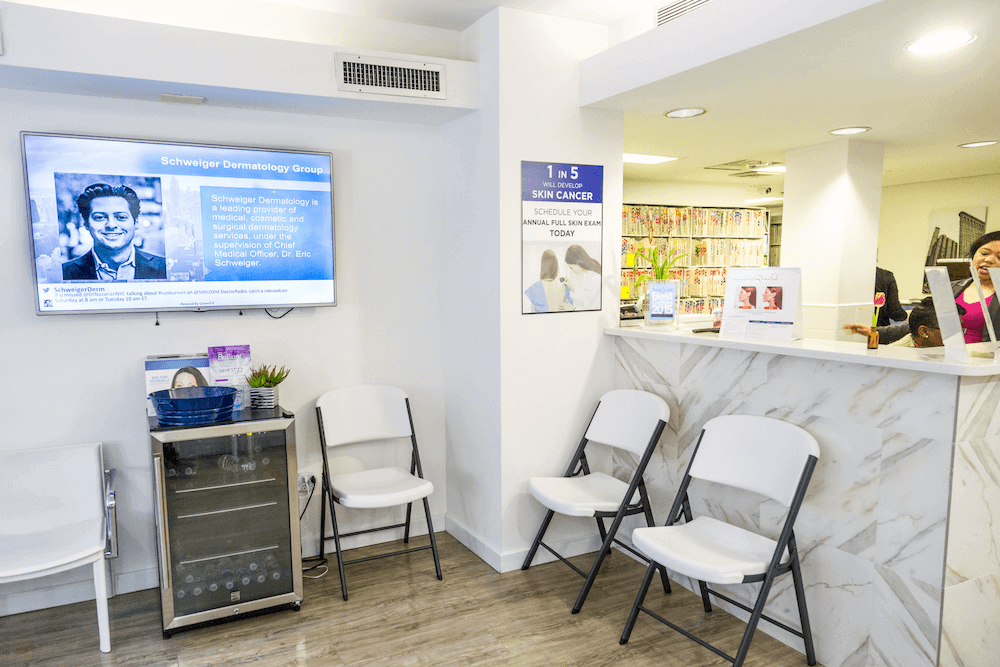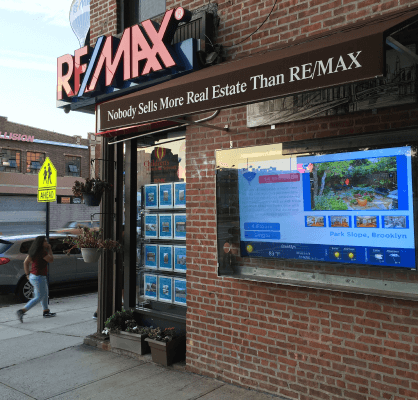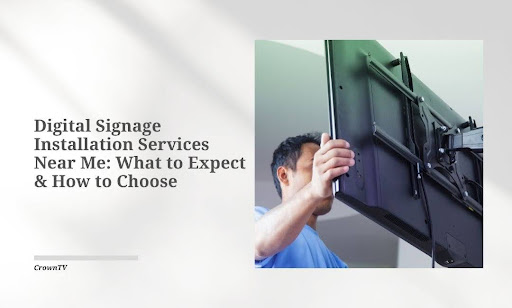You can buy the best screen on the market. Load it with the slickest content. But if the install is off—even slightly—your signage flops before it ever lights up.
- Bad mounting hides good messaging.
- Poor placement kills visibility.
- Sloppy wiring? Distracts from everything you’re trying to say.
Here’s the kicker: most installation services won’t tell you where things go wrong. They’re there to bolt the screen up, not think through how the screen works for you.
But that’s not your goal. You’re not paying for a screen on a wall. You’re investing in attention. In presence. In outcomes.
This article breaks down exactly what to expect—and what to ask—when hiring digital signage installation services near you.
You’ll learn:
- What separates a smart install from a basic mount job
- Which questions reveal if an installer actually knows signage
- The hidden costs and corners most companies skip over
- What a truly end-to-end signage setup looks like (hint: it starts before the screen arrives)
- Why it’s smarter to pick a team that does install and strategy, not just tools and tech
- How solutions like CrownTV can streamline hardware, software, content, and service in one move
If you’re done guessing where to put the screen—and tired of patching together tech and teams—this will show you what a smarter, simpler install should look like. Let’s break it down.
Why Most Installs Fall Flat Before the Screen Even Turns On
Digital signage isn’t about putting a screen on a wall. It’s about putting the right screen in the right spot with the right support behind it. Too many installs stop at surface-level decisions—screen size, wall mount, power outlet. That’s not enough. A smart install starts long before the mounting bracket comes out of the box. It begins with context.
- Where people walk.
- Where they pause.
- Where their eyes naturally land.
An effective install works with those patterns, not against them. You’re not just attaching a screen—you’re positioning an experience.
Here’s what separates a smart install from a basic one:
- It’s site-specific, not templated: A smart installer studies your layout, traffic flow, lighting, and entry points before suggesting anything. They don’t default to eye-level. They read the room.
- It accounts for distance and viewing angles: Wall-mounted screens lose their impact when glare hits or heads block the view. A smart digital signage setup avoids obstructions and keeps screen content legible from multiple angles and distances.
- It builds with scale in mind: Basic installs solve today’s needs. Smart ones think ahead—power access, content updates, device swaps, and expansion plans are baked in from the start.
- It hides the tech to highlight the content: Wires, mounts, ventilation—they shouldn’t show. Clean installs direct focus where it belongs: the screen.
- It doesn’t stop at the screen: Smart setups think beyond hardware—how will the content get updated? Who will manage it? Is the software compatible with future needs?
Most of the problems with digital signage don’t come from the display itself. They come from decisions made—or skipped—during the installation. If the goal is to grab attention and communicate clearly, your installation is the foundation. And a weak foundation sinks everything that sits on top of it.
Ask These Questions Before You Let Anyone Touch Your Walls

You can’t judge a digital signage installer by their quote alone. Or their gear list. Or how fast they say they can “get it up and running.” If you want results that hold up—not just hardware that powers on—you need to ask sharper questions.
The right answers will tell you fast whether the installer in the digital signage industry understands signage or is treating it like any other A/V project. Start here:
- “Where do you recommend placing the screens—and why?”
An experienced installer doesn’t default to walls or eye-level mounting. They’ll explain how foot traffic, lighting, and viewing angles shape their placement strategy for maximum visibility in a commercial setting. - “How do you approach glare, reflections, and ambient light?”
This isn’t a side note. It’s a major performance factor. Pros will talk through your lighting conditions and recommend commercial-grade display options with brightness levels that hold up under natural and artificial light, especially important for outdoor advertising. - “What happens if I want to scale up later?”
Smart installers plan for growth. They’ll speak to cable routing, internet connection stability, and how your nationwide digital signage network can support additional screens with minimal interruptions as your business grows. - “Do you test and calibrate the screen after installation?”
This reveals whether the job ends with a mount or includes technical setup—color balance, resolution, and system operating system alignment with your media player. Calibration is essential in delivering a visually appealing display, not just one that powers on. - “What’s your process for handling content playback?”
A good answer will go beyond plugging in a USB. Look for installers who understand how dynamic content and engaging content are handled through your CMS, media player, and content management tools, especially across professional displays. - “Can you walk me through a project you’ve done with similar challenges?”
This gives them a chance to talk shop. Their language, level of detail, and focus will tell you everything you need to know—from how they create digital signage content to how they comply with local laws and distinguish between consumer TVs and signage-grade gear.
You’re not just screening for technical know-how. You’re evaluating whether the installer understands the digital signage journey—how it differs from traditional signage, what makes high-quality signage, and the key difference between a screen that’s functional and one that delivers a stronger customer experience.
If your installer can’t explain how to keep your new signage up to date, remotely managed with a user-friendly interface, and cost-aligned to be cost-effective, they’re not ready to support your goals.
What Most Installers Don’t Include in the Quote
Installation quotes look clean on paper—until they don’t. You get the screen, the mount, the labor, and maybe a cable or two. But once work starts, the surprises pile up. Not all costs are hidden intentionally. Some are skipped because the installer isn’t thinking through the full job. Others are left out to make the initial bid look better. Either way, you end up footing the bill.
Here’s where the extra dollars usually sneak in:
- Custom mounts or reinforcements: Standard wall brackets work until they don’t. Large-format screens, ceiling drops, or irregular surfaces often require specialty mounts or reinforcements. Expect to spend an extra $150–$500 per screen if this wasn’t scoped upfront.
- Cable management and conduit work: No one wants visible wires, but clean runs need conduit, in-wall routing, or ceiling access. Add $200–$400 for each location if the job includes finishing and cleanup.
- Power outlet relocation or additions: If a power source isn’t nearby, you’ll need an electrician. That’s easily $300–$800, depending on distance, wall type, and local code requirements.
- Network setup or hardwiring: Wi-Fi might cut it for small screens. Larger networks often require hardwiring, cable pulls, or switch expansion. That could cost $150–$600 per location, depending on the complexity.
- Software configuration or training: Installers who don’t specialize in signage usually skip digital signage software setup. If you need help configuring content systems or setting up playlists, that’s another $250–$1,000, depending on scope.
- Permits and compliance requirements: Some installs—especially those in public-facing or multi-tenant buildings—require permits or sign-off from local authorities. That process can add $300–$1,200 and stretch the timeline if not handled early.
- Rework after poor placement: Miss the angle, lighting, or mounting height the first time? Moving a screen costs more than placing it right the first time. You’re looking at $200–$600 per rework, not including the hassle.
Before you sign off on a “low” quote, press for detail. Ask what’s included, what’s not, and what might come up once work begins. If a bid skips over the above, you’re not saving money—you’re setting yourself up to spend it later.
What End-to-End Digital Signage Should Actually Include

A digital signage deployment is only as effective as the process behind it. An end-to-end solution is not a marketing phrase—it’s a defined, technical workflow that begins well before procurement and continues long after installation.
To qualify as truly end-to-end, a provider must deliver the following components across five integrated phases:
1. Pre-Deployment Assessment and Site Analysis
This phase determines the viability, scope, and constraints of the deployment. It involves:
- Technical Site Surveys: Field engineers inspect architectural structures, mounting surfaces, viewing angles, pedestrian flow patterns, ceiling height, HVAC proximity, and ambient lighting levels.
- Environmental Diagnostics: Measurements are taken for temperature fluctuations, glare zones, air particulate levels (for industrial zones), and potential interference sources (EMF, Wi-Fi congestion).
- Structural Load and Power Audits: Engineers verify wall load capacity, ceiling support ratings (if applicable), and availability of 110–240V circuits, including surge protection, grounding, and proximity to electrical panels.
- Network Feasibility Reports: This includes evaluation of static IP vs DHCP availability, firewall configurations, port accessibility, VLAN segmentation requirements, and bandwidth availability per display node.
2. System Design and Engineering
Once the site data is collected, engineers move into architectural design and systems integration:
- Hardware Engineering: Selection of display types (e.g., LCD vs LED, SoC vs external media player), resolution standards (FHD, 4K, ultra-wide), nit brightness matching (e.g., 350–700+ for indoor; 2500+ for outdoor signage), and lifespan considerations (MTBF ratings, duty cycle).
- Mounting System Specifications: Design includes ADA compliance, anti-theft locking mechanisms, tilt/swivel configuration, load-bearing torque ratings, and vibration-resistance for high-traffic environments.
- Signal Distribution Architecture: Definition of video signal pathways using HDMI, DisplayPort, SDVoE, or AV-over-IP protocols. Cable length calculations must include attenuation thresholds and shielding requirements.
- Media Playback and Control Systems: Integration of media players, content delivery networks (CDNs), and synchronization capabilities. Compatibility with CMS platforms, remote firmware management, and device health monitoring systems must be confirmed.
3. Physical Installation and System Integration
This step translates the engineering blueprint into physical infrastructure:
- Display Mounting and Alignment: Digital Signage displays are installed with precise vertical and horizontal tolerances (<2mm deviation), leveled using industrial-grade laser guides. Cabling is terminated with strain relief and labeled per rack unit or zone.
- Electrical and Network Commissioning: Power delivery is tested under load. PoE+ or direct AC setups are verified. Cat6A, fiber, or coaxial runs are terminated with signal integrity testing. Devices are assigned IPs, verified via the MAC address registry, and integrated into the facility’s network.
- CMS and Playback System Integration: CMS credentials are configured; playlists are uploaded; test content is deployed to validate compatibility across formats (.mp4, .mov, HTML5, etc.). Failover behavior is simulated to validate playback continuity.
4. QA, Calibration, and Acceptance Testing
Technical commissioning is followed by system-wide validation:
- Color and Brightness Calibration: Displays are calibrated using spectroradiometers to achieve uniform white point (D65) and gamma curves. Ambient light compensation settings are configured per zone.
- Playback Performance Testing: Content rendering is tested for stuttering, dropped frames, loading delays, and image distortion. Audio synchronization and volume normalization tests are also performed, where applicable.
- Thermal Load Testing: Thermal cameras monitor heat dissipation from screens and players during continuous 8-hour operation. Cooling systems (passive or active) are adjusted as necessary.
- Network Stress Testing: Streaming performance is tested under simulated peak load. Packet loss, jitter, and latency are logged and reviewed for each node.
5. Handover, Documentation, and Long-Term Support
A successful deployment ends with structured handoff and lifecycle planning:
- As-Built Documentation: Includes screen matrix diagrams, cable paths, power layouts, MAC/IP logs, CMS structure, and failover protocols.
- Training and SOPs: On-site or remote training sessions are conducted for all relevant personnel. Standard operating procedures (SOPs) and escalation workflows are documented for both routine and emergency scenarios.
- Ongoing Maintenance and SLA: Providers should offer Service Level Agreements (SLAs) covering routine inspections, uptime guarantees, on-site replacements, and software update cycles. Remote monitoring tools should enable real-time diagnostics, alerting, and proactive issue resolution.
A provider that skips any of these layers isn’t offering an end-to-end solution. They’re delivering a partial system—one that’s prone to failure, inefficiency, and long-term cost exposure.
End-to-end means engineered integration across hardware, software, physical installation, and operational continuity. Anything less invites risk.
Why Installation Without Strategy Leads to Inefficient Systems
Digital signage requires more than technical execution. It demands alignment with business intent, user behavior, and operational context.
Selecting a team that handles both installation and digital signage strategy is the difference between a functioning system and a high-performing one. A provider limited to digital signage hardware and installation lacks the insight to guide critical upstream decisions—ones that directly influence performance, usability, and return on investment.
Here’s where strategy-integrated teams deliver operational advantages:
- Clear Objectives Drive Technical Decisions: Strategic teams start with questions like:
- What role will signage play in the environment?
- Who is the intended audience?
- What KPIs will define success—engagement, conversions, wayfinding accuracy, or dwell time?
These answers shape every downstream decision, from screen placement and orientation to content design and scheduling protocols.
- Hardware Choices Reflect Functional Goals: Strategy-led providers specify display size, resolution, brightness, and control interfaces based on defined use cases. For example:
- Interactive wayfinding requires touch-capable digital displays with impact-resistant surfaces and integrated gesture calibration.
- Ambient branding may call for ultra-wide displays with passive media players and scheduled content loops.
- Transactional interfaces demand commercial-grade durability, input redundancy, and latency-optimized media processing.
Without strategic context, teams often over-specify or under-specify components, wasting budget or limiting performance.
- Content Deployment is Treated as Core Infrastructure: Non-strategic teams often treat content as a post-installation task. Strategic teams integrate content workflows into the build phase, ensuring:
- CMS compatibility with internal systems (HR feeds, CRM data, POS integrations)
- Automated content scheduling linked to operational triggers (e.g., time-of-day, occupancy sensors)
- Layout design aligned with focal zones and cognitive load principles
This tight coupling of content and context enhances visibility and usability while reducing internal workload.
- Long-Term Operational Risk is Reduced: Teams that handle both deployment and strategy account for future changes in:
- Organizational structure
- Content ownership
- Tech stack evolution
- Maintenance staffing
This foresight leads to modular system design, streamlined SOPs, and scalable network architecture—all critical to lifecycle cost control.
- One Point of Accountability: With separate vendors, failures trigger finger-pointing between the tech installer and the content strategist. A unified team takes responsibility for the entire system—design, deployment, and performance. Escalation becomes direct. Issue resolution is faster. Communication overhead drops.
A signage system is not just a technical project—it’s an operational asset. Selecting a team that integrates installation with strategic planning ensures your system performs as intended, scales with your needs, and supports your business goals from day one.
How CrownTV Delivers a Unified Digital Signage Infrastructure

Most signage companies fail at the integration stage, not because of bad equipment, but because of fragmented vendors. One handles the hardware. Another installs the screens. A third touches the CMS. And when problems arise, responsibility disappears.
CrownTV eliminates this fragmentation entirely. As a full-scope sign company, CrownTV provides a system-level solution that merges hardware, software, content creation, and support into one operational framework. That level of consolidation reduces risk, accelerates timelines, and lowers hidden software costs.
Hardware and Installation Are Engineered Together
CrownTV doesn’t treat screens, media players, mounts, and cabling as independent elements. Everything is tested and deployed as part of a pre-engineered system.
- Screens are commercial-grade signage, matched to brightness needs and ambient light conditions
- CrownTV’s proprietary best digital signage hardware delivers consistent performance with secure storage and reliable playback
- Mounting hardware is selected based on surface type, screen weight, and ventilation needs, critical for storage capacity and component longevity
Unlike many vendors, CrownTV handles the full installation process directly. There’s no subcontracting. No delays. Install pricing starts at $295 for the first hour and $195 per additional hour.
Software Configuration is Included, Not Left Behind
CrownTV doesn’t hand off configuration to an external firm. Every element—from dashboard setup to device syncing—is completed in-house.
- Their cloud CMS offers remote management across multiple screens, eliminating the need for on-site changes
- User access can be segmented by department, region, or building
- Content scheduling is precise to the minute, and changes update automatically without device-side interaction
No third-party patchwork. No integrations left unfinished. From content templates to network connectivity, CrownTV handles it all.
Content Delivery and App Integration Work Seamlessly
Content limitations aren’t part of the CrownTV workflow. The platform supports:
- Video loops, stills, and interactive elements
- HTML5 displays
- Live social media feeds
- API-based integrations for internal data systems, wayfinding, and digital menus
The system connects with tools used by retail stores, corporate offices, education facilities, and more, offering integration capabilities far beyond basic screen casting. Thanks to multiple HDMI ports and broad signage technology compatibility, clients aren’t restricted to a narrow set of content types or layouts.
Service and Support Are Embedded—Not Outsourced
From deployment to uptime management, CrownTV’s support team handles:
- Onboarding and training
- System-level troubleshooting
- Regular CMS updates
- Preventive maintenance for hardware and networking components
That means one point of contact. Full-stack accountability. No escalation loops between different signage companies or tech providers.
While others mix consumer-grade TV products into commercial systems, CrownTV builds every deployment around reliability, network security, and high-availability infrastructure. The result? A seamless digital signage experience across multiple locations, departments, and user groups.
CrownTV doesn’t offer pieces of a system. It delivers digital signage solutions as a complete, scalable infrastructure—from screen to content, from deployment to control. For organizations serious about digital signs, long-term usability, and measurable results, that kind of integration is no longer optional—it’s operationally necessary.
Choosing Digital Signage Installation Services Doesn’t Have to Be a Guessing Game
If you’ve followed the right steps, asked the right questions, and chosen a team that handles both the install and the strategy, here’s what changes:
- Your screens won’t get ignored—they’ll pull focus in the exact places they should.
- Your tech won’t break under pressure—it’ll scale as your needs evolve.
- Your content won’t get bottlenecked—it’ll run clean, automated, and timely across every location.
You won’t have to waste time chasing vendors, fixing sloppy installs, or redoing work that should’ve been done right the first time. Instead, you’ll launch a signage system that supports business outcomes—driving better decisions, smoother workflows, and a stronger in-store experience where every screen earns its place.
When signage is built on quality materials, tailored with a clear content strategy, and deployed from a central location, your messaging remains sharp, even across complex environments. More importantly, your system won’t struggle to create content at scale or deal with underpowered devices. It’ll run on displays with the processing power to handle motion graphics, dynamic menu boards, and real-time feeds without lag.
This only works when your install team brings a deep understanding of how signage systems actually perform in live environments—and knows that not all platforms are created equal. CrownTV doesn’t separate the pieces. We bring the hardware, including digital signage player, software, content, and service, into one streamlined system—so you can stop managing parts and start seeing results.

